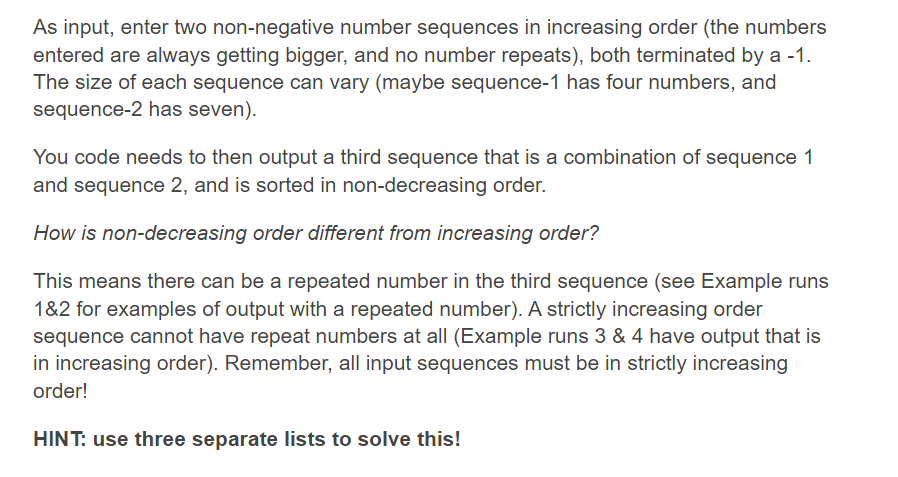As input, enter two non-negative number sequences in increasing order (the numbers entered are always getting bigger, and no number repeats), both terminated by a -1. The size of each sequence can vary (maybe sequence-1 has four numbers, and sequence-2 has seven). You code needs to then output a third sequence that is a combination of sequence 1 and sequence 2, and is sorted in non-decreasing order. How is non-decreasing order different from increasing order?
As input, enter two non-negative number sequences in increasing order (the numbers entered are always getting bigger, and no number repeats), both terminated by a -1. The size of each sequence can vary (maybe sequence-1 has four numbers, and sequence-2 has seven). You code needs to then output a third sequence that is a combination of sequence 1 and sequence 2, and is sorted in non-decreasing order. How is non-decreasing order different from increasing order?
Database System Concepts
7th Edition
ISBN:9780078022159
Author:Abraham Silberschatz Professor, Henry F. Korth, S. Sudarshan
Publisher:Abraham Silberschatz Professor, Henry F. Korth, S. Sudarshan
Chapter1: Introduction
Section: Chapter Questions
Problem 1PE
Related questions
Question
This problem is require to use Python

Transcribed Image Text:As input, enter two non-negative number sequences in increasing order (the numbers
entered are always getting bigger, and no number repeats), both terminated by a -1.
The size of each sequence can vary (maybe sequence-1 has four numbers, and
sequence-2 has seven).
You code needs to then output a third sequence that is a combination of sequence 1
and sequence 2, and is sorted in non-decreasing order.
How is non-decreasing order different from increasing order?
This means there can be a repeated number in the third sequence (see Example runs
1&2 for examples of output with a repeated number). A strictly increasing order
sequence cannot have repeat numbers at all (Example runs 3 & 4 have output that is
in increasing order). Remember, all input sequences must be in strictly increasing
order!
HINT: use three separate lists to solve this!
Expert Solution
This question has been solved!
Explore an expertly crafted, step-by-step solution for a thorough understanding of key concepts.
Step by step
Solved in 2 steps with 2 images

Knowledge Booster
Learn more about
Need a deep-dive on the concept behind this application? Look no further. Learn more about this topic, computer-science and related others by exploring similar questions and additional content below.Recommended textbooks for you

Database System Concepts
Computer Science
ISBN:
9780078022159
Author:
Abraham Silberschatz Professor, Henry F. Korth, S. Sudarshan
Publisher:
McGraw-Hill Education

Starting Out with Python (4th Edition)
Computer Science
ISBN:
9780134444321
Author:
Tony Gaddis
Publisher:
PEARSON

Digital Fundamentals (11th Edition)
Computer Science
ISBN:
9780132737968
Author:
Thomas L. Floyd
Publisher:
PEARSON

Database System Concepts
Computer Science
ISBN:
9780078022159
Author:
Abraham Silberschatz Professor, Henry F. Korth, S. Sudarshan
Publisher:
McGraw-Hill Education

Starting Out with Python (4th Edition)
Computer Science
ISBN:
9780134444321
Author:
Tony Gaddis
Publisher:
PEARSON

Digital Fundamentals (11th Edition)
Computer Science
ISBN:
9780132737968
Author:
Thomas L. Floyd
Publisher:
PEARSON

C How to Program (8th Edition)
Computer Science
ISBN:
9780133976892
Author:
Paul J. Deitel, Harvey Deitel
Publisher:
PEARSON

Database Systems: Design, Implementation, & Manag…
Computer Science
ISBN:
9781337627900
Author:
Carlos Coronel, Steven Morris
Publisher:
Cengage Learning

Programmable Logic Controllers
Computer Science
ISBN:
9780073373843
Author:
Frank D. Petruzella
Publisher:
McGraw-Hill Education